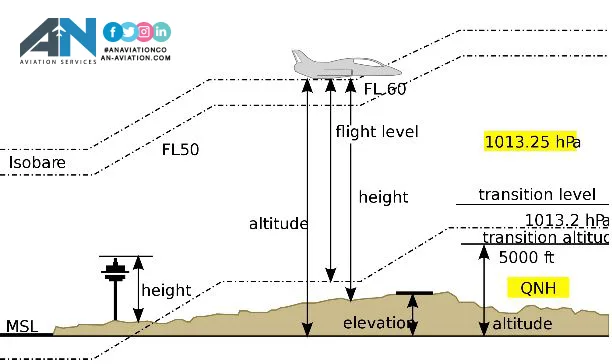
Height, Altitude, and Flight Level
You might have heard the word altitude many times when traveling, either from the captain’s announcements during a flight or you might have seen it on the in-flight entertainment screen.
But is altitude the only aircraft elevation level that guides pilots during flights?
No, it’s not the only elevation level. In aviation, there are three types of aircraft elevation. Each is different from the other by reading the reference altitude.
1. Height
It is simply the distance between the plane and the ground underneath directly influenced by the rise of terrains.
For example, if you fly at an altitude of 100 feet above the ground and passed on a plateau height of 70 feet, suddenly your height above ground becomes 30 feet only.
This kind of elevation is not used mainly in aviation, but it is very important in some cases as at work if you have to do an autopilot landing, where the autopilot uses this to see the remaining distance for the wheels to touch the runway.
2. Altitude
Elevation above sea level.
And so-called altitude is used for the purpose of take-off and landing and flying low until a certain height varies from one place to another. The maximum height used is 15,000 feet and 18,000 feet in some countries, like America.
This attitude doesn’t show your height above the ground. For instance, if you fly at an altitude of 5000 feet above Riyadh airport, the actual height above Riyadh airport is 3000 feet because Riyadh is two thousand feet above sea level.
And a tower or a mountain is measured from the height of the sea surface in aviation, not the height of the earth’s surface.
It should be noted that the altitude is based on the amount of atmospheric pressure above the sea surface, where QNH atmospheric pressure varies from one place to another as it differs through time even if it’s in the same place.
3. Flight level and abbreviated FL.
This increment is based on a fixed reference which is basically the amount of pressure 1013 Hectopascal, and this reference for measuring this elevation is fixed around the world.
All the pilots use this elevation when flying at high altitudes up to 30,000 feet and above.
There are two specific elevations that pilots shift between. It’s the altitude and FL, and this transactional switch is called transition altitude/level.
In Gulf countries, TA is on the height of 13,000 ft, and TL is on the height of 15,000 ft.


